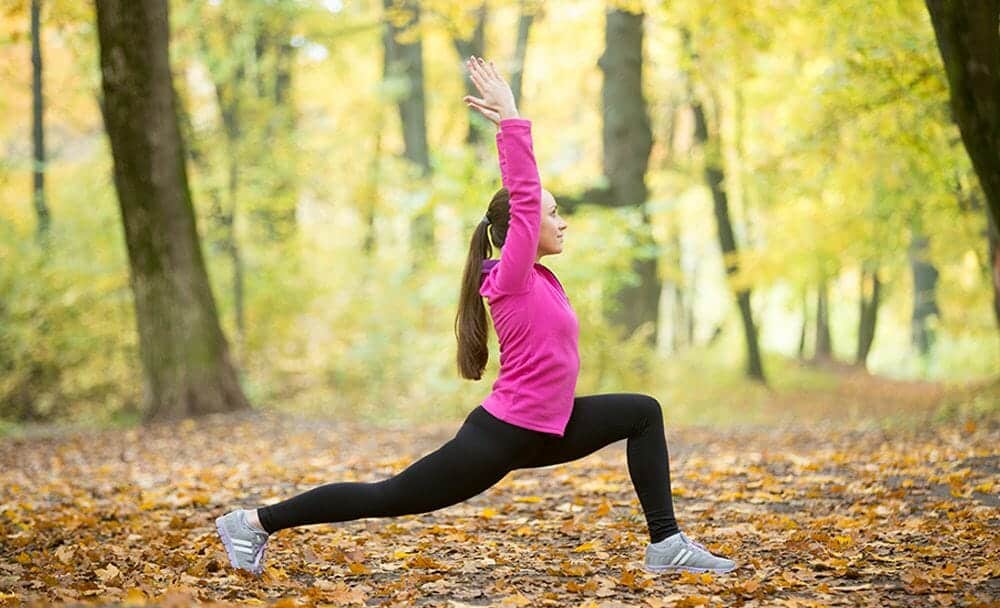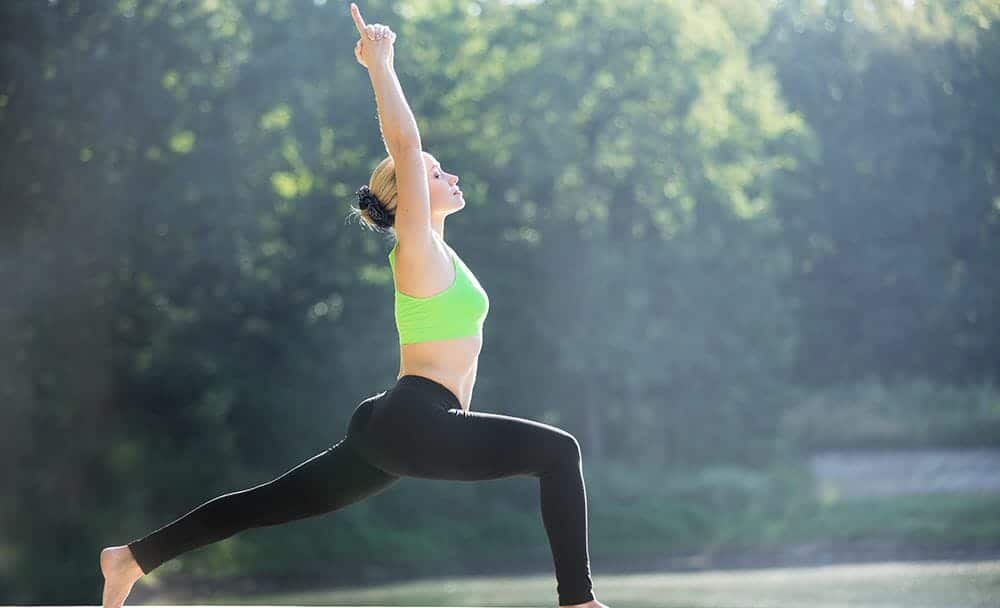
Virabhadrasana, or the warrior pose, is a testament to strength, determination, and balance in yoga. Rooted in ancient yogic tradition, this asana embodies the fierce spirit of a warrior, symbolizing physical and mental prowess. Beyond its external elegance, virabhadrasana holds many profound benefits for practitioners, from enhanced muscular strength and flexibility to fostering concentration.
This guide looks into the intricacies of virabhadrasana, exploring its advantages. We also offer a meticulous step-by-step guide on executing this pose precisely. So, let’s understand how embracing virabhadrasana can pave the way for a harmonious fusion of body and mind.
What is the virabhadrasana yoga pose?
Virabhadrasana is a fundamental asana in yoga practice renowned for its capacity to cultivate strength and resilience in various muscle groups. The virabhadrasana warrior pose systematically reinforces physical endurance and muscular balance by actively engaging the arms, shoulders, thighs, and back muscles.
The nomenclature of virabhadrasana originates in Hindu mythology and is attributed explicitly to Virabhadra, a formidable warrior and incarnation of Lord Shiva. Rooted in an ancient tale that emerges from the Upanishads, the narrative of the warrior Virabhadra captivates with its mythical essence. It also imparts profound moral lessons, thus enriching our lives through its significance. [1]

What are the benefits of the virabhadrasana pose?
The virabhadrasana pose brings the following physical benefits that contribute to holistic well-being.
- Muscular strengthening
The asana effectively strengthens and tones the shoulders, arms, legs, and lower back. It contributes to muscular stability and endurance. [1]
- Comprehensive stretching
Virabhadrasana stretches the chest, lungs, shoulders, neck, belly, and groin (psoas) region. It leads to increased flexibility and improved mobility. [1]
- Enhanced balance and stamina
Practicing the pose aids in enhancing body balance and building stamina. It is precious for individuals seeking to boost their physical endurance. [1]
- Counteracting sedentary lifestyle effects
For those with deskbound jobs, virabhadrasana serves as a valuable countermeasure. It helps alleviate the adverse effects of prolonged sitting. [1]
- Therapeutic benefits for frozen shoulders
The pose proves highly beneficial for individuals with frozen shoulder conditions, facilitating relief and restoring a more comprehensive range of motion. [1]
- Effective stress release
Virabhadrasana efficiently releases stress and tension within the shoulders. It offers an effective means of relaxation within a short timeframe.
- Thighs, calves, and ankles
The asana simultaneously strengthens and stretches the muscles of the thighs, calves, and ankles for improved lower-body functionality. [1]

How does the virabhadrasana pose?
Follow these step-by-step instructions to execute the pose with accuracy.
- Step 1: Initial position
Begin by standing in Tadasana, also known as the mountain pose. On an exhale, create a separation between your feet, maintaining a distance of approximately 3 to 4 feet. Simultaneously, raise your arms perpendicularly to the floor, ensuring they remain parallel. Engage your scapulae against your back, drawing them towards your coccyx for a firm foundation. [1]
- Step 2: Establishing alignment
Rotate your left foot around 45 to 60 degrees to the right, and pivot your right foot 90 degrees to the right. Align your right heel with the left. Exhale as you gently rotate your torso to the right to bring the front edge of your mat as close to the pelvis as possible. While your left hip point moves forward, ground the left heel by pressing the head of the left femur backward. Extend your coccyx downward and gradually lower your upper torso back.
- Step 3: Initiating the pose
To anchor the left heel securely to the floor, exhale and then bend the right knee over your right ankle. It should result in your body becoming perpendicular to the floor.
- Step 4: Elevating the pose
Initiate a firm upward movement from your pelvis, elevating your ribs away from the pelvis. As you root down with the back foot, experience a rising sensation that travels up your back leg, abdomen, chest, and into your arms. Bring your palms together, positioning them against each other. Extend slightly upwards through the pinky sides of your hands. Maintain a neutral position for your head, keeping your gaze forward or, if comfortable, tilting it backward to gaze at your thumb.
- Step 5: Holding the pose
Maintain this pose for around a minute, focusing on controlled breathing and maintaining alignment. To exit the pose, exhale while pressing your back heel firmly into the ground. Simultaneously, extend your arms as you straighten your right knee. Rotate your legs to face forward and release your arms while breathing naturally. For an added challenge, keep your arms raised upwards. Take a few deliberate breaths in this position. Subsequently, bend your legs to the left and replicate the pose for an equivalent duration. Upon completing the pose, gently return to the Tadasana position.
Precautions to know when performing the virabhadrasana pose
As with any yoga posture, achieving virabhadrasana requires a mindful approach. Adhering to these precautions ensures a beneficial practice.
- High blood pressure concerns
Individuals with high blood pressure should avoid this posture. The intense physical exertion involved may not be suitable for their condition. [1]
- Pregnancy and practicing yogis
Pregnant women in their second and third trimesters can benefit from virabhadrasana if they have a consistent yoga practice. However, consulting a medical professional before practicing is essential to ensure the safety of both mother and baby. [1]
- Use of wall support
When practicing virabhadrasana, positioning oneself close to a wall for support is advisable, particularly for beginners or those seeking stability. Consultation with a healthcare professional before attempting this posture is suitable. [1]
- Gastrointestinal health
Individuals dealing with or recovering from diarrhea should refrain from practicing virabhadrasana, as the pose’s physical demands could exacerbate their condition. [1]
- Knee pain or arthritis
If you have knee pain or arthritis, consider using additional support at the knee area to maintain the pose with ease and comfort. [1]
- Cardiovascular issues
Individuals with heart-related concerns should avoid virabhadrasana, as the pose involves significant physical effort and could strain the cardiovascular system. [1]
- Shoulder problems
Practitioners experiencing shoulder problems should ensure their raised arms remain either parallel to each other or slightly wider. This adjustment helps alleviate strain on the affected areas. [1]
- Neck health
Those with neck problems should maintain a neutral head position and avoid looking upwards at the raised hands to prevent unnecessary strain on the neck. [1]
FAQs
1. What is virabhadrasana I?
Virabhadrasana I, also known as the warrior pose I, is a yoga asana that involves standing with one leg forward, knee bent, and arms raised overhead. It symbolizes the stance of a warrior and offers various physical and mental benefits.
2. What is virabhadrasana II?
Virabhadrasana II, or warrior pose II, is a yoga posture where one stands with arms stretched out horizontally, legs spread apart, and the front foot pointing forward. In contrast, the back foot is turned sideways. The pose focuses on stability and balance.
3. What is virabhadrasana III?
Virabhadrasana III, or warrior pose III, is a dynamic yoga pose that involves balancing on one leg while the other leg extends behind the body. The arms are typically stretched forward. This pose enhances strength, balance, and focus.
4. What is viparita virabhadrasana?
Viparita virabhadrasana, or reverse warrior pose, is a yoga posture involving a deep side stretch while one arm reaches upward and the other rests on the back leg. It provides a stretch to the side of the body and can aid in improving flexibility.
5. What are the benefits of virabhadrasana I?
Virabhadrasana I offers benefits like strengthening the legs, shoulders, and back, enhancing flexibility, promoting concentration, and cultivating a sense of inner power and determination.
6. What are virabhadrasana variations?
Several variations of virabhadrasana cater to different levels of flexibility and strength. These variations can include modifications in arm placement, leg positioning, and the angle of the feet.
7. What is the virabhadrasana procedure?
The procedure for virabhadrasana involves standing with a wide-legged stance, lunging or bending one knee, positioning the arms as per the variation, and focusing on maintaining balance and alignment. The specific steps may change based on the interpretation being practised.
Conclusion
Virabhadrasana weaves strength, grace, and a profound connection between the body, mind, and spirit. From its ability to enhance muscular strength and flexibility to its role in fostering mental resilience and balance, virabhadrasana is a testament to yoga’s transformative potential. Embracing the embodiment of the warrior’s spirit allows practitioners to embark on a journey of self-discovery and inner empowerment.
Disclaimer
The information provided here does not intend to replace professional advice or treatment.
References
















